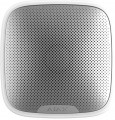Usage
The method of use normally provided for by the siren design. Simply put, the environmental conditions in which it can be used.
-
Street. Devices designed for use outdoors or outdoors (or in rooms where the climate is not particularly different from the outdoors). When used in this way, the siren is exposed to a number of adverse effects - high and low temperatures, sunlight, fit, dust, etc. Street models are characterized by a high degree of body protection, allowing them to endure the mentioned “troubles” without consequences. However, it must be taken into account that the specific range of protection, operating temperature and humidity may vary.
-
In room. Devices designed for use in enclosed spaces. Conditions “under the roof” are milder than outside, so such sirens do not require particularly advanced housing protection. In addition, they often differ from street models in a more neat and compact appearance - after all, the device must not only perform its direct functions, but also more or less fit into the interiors of the premises.
Note that technically, outdoor models can also be used indoors. This is not always justified in terms of price and design, but even the manufacturers themselves sometimes claim this possibility. But the opposite option - installing a siren for outdoor premises - is extremely undesirable: even in ideal weather, such a device most likely wi
...ll not work for a long time, and its correct functioning is not guaranteed.Communication range
The communication range provided by a wireless siren is the greatest distance to a neighboring device, which ensures uninterrupted communication.
However, it must be taken into account that this parameter is usually given for ideal conditions - within line of sight, without obstacles in the signal path and interference in the range used. In practice, the range of action may be noticeably lower - especially when working through walls; Therefore, it is worth choosing according to this indicator with a certain reserve. At the same time, the rule “the more the better” fully applies here: a longer range contributes to the overall reliability and stability of the connection.
Volume
The volume of the siren, expressed in decibels (dB).
The
louder the siren, the higher the likelihood that the alarm will attract maximum attention. In addition, loud noises can have a psychological and disorienting effect on intruders. Alarm sirens become very noisy: in the “quiest” ones, the volume level is about 70 - 80 dB, which can be compared with a noisy city street, the ringing of an alarm clock or a scream at a distance of about 1 m. In the loudest instances, this value reaches 130 dB, which is comparable with the sound of a working hammer drill, the pain threshold is located at approximately the same level. More detailed comparisons of different volume values with real sound sources can be found in special tables.
Protection class
The protection class is traditionally designated according to the IP standard - the “IP” marking with two numbers, each of which corresponds to its own indicator. So, the first number describes protection against the penetration of dust and foreign objects. The following options may occur:
— 2. Protection against objects with a thickness of 12.5 mm or more, prevents the penetration of fingers.
— 3. Protection against objects with a thickness of 2.5 mm, in particular many tools.
— 4. Protection against objects with a thickness of 1 mm, such as most wires.
— 5. Complete protection from contact of the “internals” with foreign objects, resistance to dust (it can penetrate inside the case, but in scanty quantities that do not affect the operation of the device).
— 6. Completely closed body, preventing dust from getting inside.
Note that this parameter only describes the mechanical protection provided by the case (roughly speaking, the size of the holes in it and objects that can get inside). In this case, there is no talk of protection against opening and interference with work - this is a completely separate nuance, implemented in other ways.
The second digit in the IP marking characterizes the degree of protection against moisture:
— 0. Complete absence of any protection; water entering the body is not allowed.
— 1. Protection from vertical drops of water.
— 2. Protection from vertical drops when...the body is tilted up to 15° from the standard position.
— 3. Protection against splashes falling on the body at an angle of up to 60° to the horizontal, the minimum indicator that allows us to talk about resistance to rain.
- 4. Protection against splashes from any direction, allows you to safely withstand rain and strong winds.
— 5. Protection from water jets from any direction, resistance to storms.
— 6. Protection from strong water jets or strong sea waves (when the device can be completely hidden under the wave for a short time).
The degree of IP protection is especially important to consider when choosing outdoor models - they are the ones most susceptible to adverse effects. It is worth noting here that if the degree of protection is not indicated, this does not mean that the device is “defenseless”. The only point is that it has not undergone official IP certification, but the actual degree of protection can be quite high (in such cases it should be clarified according to the manufacturer’s documentation). At the same time, we emphasize that a certain degree of IP protection in itself does not guarantee the possibility of outdoor use - after all, the siren must withstand not only moisture and dust, but also temperature changes, sunlight and other adverse environmental factors.
Operating temperature
The range of ambient temperatures in which the siren is guaranteed to remain operational.
All modern sirens are able to withstand temperatures typical of residential and office premises without consequences. Therefore, it makes sense to pay attention to this parameter mainly in cases where the device is planned to be used in more unfavorable conditions - for example, on the street, in an unheated room, in a “hot” industrial workshop, etc. At the same time, we emphasize that even for the most For “heat-resistant” models, exposure to direct sunlight is undesirable - they can heat the case to temperatures significantly higher than permissible.
Maximum humidity
The highest relative air humidity at which the siren can be used.
Many models can easily tolerate short-term (up to several hours) stay in a more humid atmosphere; however, for a complete guarantee, it is still better not to exceed the permissible humidity. As for specific numbers, in residential/office spaces (and similar environments) the relative humidity rarely exceeds 70%. But for outdoor use and rooms with high humidity (swimming pools, laundries, etc.), it is advisable to use sirens designed for a humidity of at least 90%.

